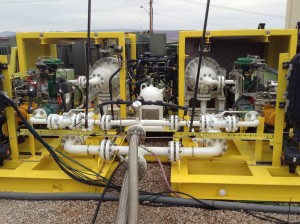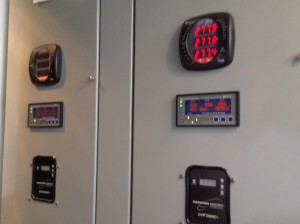
ST. GEORGE – Thursday and Friday, St. George startup company Helidyne LLC held equipment demonstrations at its newly completed test stand, located at the City of St. George Red Rock generating facility.
Founded in 2008, Helidyne has developed “a new rotary positive displacement gas expander for waste pressure recovery applications,” according to a Helidyne press release.

Information from the release stated the planetary rotor expander is a unique, self-cleaning design that is rated to 1,440 pounds of pressure per square inch, or psi. Unlike competitors in the business, it can handle “wet” gas at the expander inlet.
This startup company, which began with inventing in a garage, has now taken order on its first four units which have been purchased by Pemex, cofounder and CEO Kevin Kerlin said, the world’s sixth largest oil and gas producer.
The four units will be installed on two production oil platforms located 60 miles offshore in the Gulf of Mexico and will be used to power the platforms. The units can power the platform’s electricity, computers, heating and air, Kevin Kerlin said, and are less costly than diesel fuel that has to be shipped in.
Additionally the units are emission free because the expander is noncombustive, stated the press release, adding that, “if used for waste pressure recovery, (the unit) qualifies for renewable tax credits.”
The rotors will be driven by an onshore high pressure natural gas or nitrogen compressor station and will create a closed inlet/outlet loop using existing gas lines.
The units are coupled for redundancy, or in other words, they are sold in pairs so that if one of them stops working the other will take over, and they are rated to produce up to 60 kilowatts of power a piece.
Pemex, who ordered the first four “beta” units from Helidyne over a year ago, has strict standards for the manufacturing and testing of the units including the paint scheme, Kevin Kerlin said. The units have had to be completely disassembled, repainted and reassembled because the yellow shade was not up to spec, Mechanical Engineer Andy Kerlin said.

Because of their strict standards, Helidyne had a need for a test site to do a functionality test on the units before they can become Pemex certified. Through a partnership with the City of St. George Energy Service Department and with the assistance of Questar Gas, Helidyne was able to lease property at the Red Rock generating facility and construct a test stand.
“The city really accommodated us,” Kevin Kerlin said. “This site is so critical to us.”
Helidyne represents a great opportunity for the community to support small business and create economic stability, Scott Hirschi, director of Site Select Plus, said.
The company had humble beginnings, spending nearly three years in the inventing process, Kevin Kerlin said, but added that they are likely the first group to take the planetary rotor expander from conception to a working unit.
“It has been a painful commercialization process,” Andy Kerlin said.
Helidyne has logged approximately 140 test hours at the new site, Andy Kerlin said, and the next step is to get to 1,000 hours. The company’s management hopes to complete testing and certification by Pemex and have the first units shipped out in early 2015, and is hopeful for another order of 16 more units, Kevin Kerlin said.
While their current market is providing power generation packages for offshore platforms, Kevin Kerlin said, the nature of their expander’s design and its ability to work in harsh environments will allow for other applications such as gas processing and he looks forward to continued growth and opportunity.
Helidyne invited a select group of people, including press, Questar gas representatives, several of the company’s vendors, representatives of banking establishments, St. George Energy Services Department employees and Mayor Jon Pike to attend one of four demonstrations held over the course of Thursday and Friday to see firsthand the new test site, the equipment and meet with Helidyne employees.
Click on photo to enlarge it, then use your left-right arrow keys to cycle through the gallery.

St. George startup, Helidyne, gives a demonstration of their planetary rotor expander units at their new test stand located at the Red Rock Power Generating facility, St. George, Utah, Dec. 11, 2014 | Photo by Hollie Reina, St. George News

St. George startup, Helidyne, gives a demonstration of their planetary rotor expander units at their new test stand located at the Red Rock Power Generating facility, St. George, Utah, Dec. 11, 2014 | Photo by Hollie Reina, St. George News

St. George startup, Helidyne, gives a demonstration of their planetary rotor expander units at their new test stand located at the Red Rock Power Generating facility, St. George, Utah, Dec. 11, 2014 | Photo by Hollie Reina, St. George News
Related posts
- New EPA regulations could increase power rates for St. George residents
- Another foxy power outage leaves St. George residents in the dark
- Outlier conference promotes startup businesses, building relationships
Email: [email protected]
Twitter: @STGnews
Copyright St. George News, SaintGeorgeUtah.com LLC, 2014, all rights reserved.

